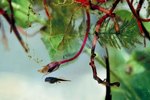
The western chorus frog (Pseudacris triseriata) is a wee amphibian that's relatively abundant throughout parts of the United States and Canada. These brown, beige, reddish or grayish frogs feature striping on their sides and backs. As their names suggest, western chorus frogs are quite noisy creatures, what with their signature brief and gravelly calls. In times of mating, these frogs are particularly cacophonous creatures.
About Western Chorus Frogs
Western chorus frogs usually range from between 1 and 1.5 inches in body length, indicates the Department of Natural Resources for Michigan. In most cases, the females are a little bigger than the males. Western chorus frogs' skin has an uneven and damp texture. Their toes are web-free. These nocturnal frogs can thrive in many types of environments, as long as they're sufficiently moist. Some examples of suitable and common western chorus frog habitats are meadows, wetlands, marshes, ponds, surroundings of forests and agricultural sites. They occasionally reside in urban locales, but are particularly fond of airy environments. Western chorus frogs generally are drawn to transient bodies of water -- a means of staying away from fish. Fish frequently feed on tadpoles and juveniles of the species, after all. Western chorus frogs' reproductive seasons begin in the middle of March and end around the close of May each year.
Diet
Western chorus frogs consume carnivorous diets -- with an emphasis on insects. Some of these amphibians' favorite bugs to eat are thrips, leafhoppers, beetles, flies and ants. They also frequently eat spiders, worms and tiny snails.
Youngster Diet
The tadpoles of the species do not feed on insects like the adults, but rather on algae. Younger frogs also have slightly differing diets than the adults, as they rely mostly on tinier bugs -- think springtails, midges and mites, for example.
Predators
Western chorus frogs also have an array of predatory animals to worry about, such as striped skunks, great blue herons, raccoons, snakes and shrews. Since western chorus frogs are so diminutive, bigger varieties of frogs also go after them as prey -- especially when they are juveniles.
References
- Cleveland Museum of Natural History: Pseudacris triseriata
- Indiana Department of Natural Resources: Western Chorus Frog
- University of Michigan BioKIDS: Western Chorus Frog
- Reptiles of Arizona: Western Chorus Frog
- University of Michigan Animal Diversity Web: Pseudacris triseriata
- Ohio Department of Natural Resources: Western Chorus Frog
- Colorado Division of Wildlife: Western Chorus Frog
- IUCN Red List of Threatened Species: Pseudacris triseriata
- Illinois Natural History Survey: Western Chorus Frog
- University of Wisconsin Sea Grant: The Western Chorus Frog
Photo Credits
-
Jupiterimages/Comstock/Getty Images




